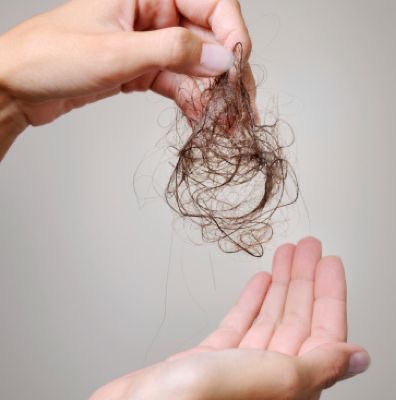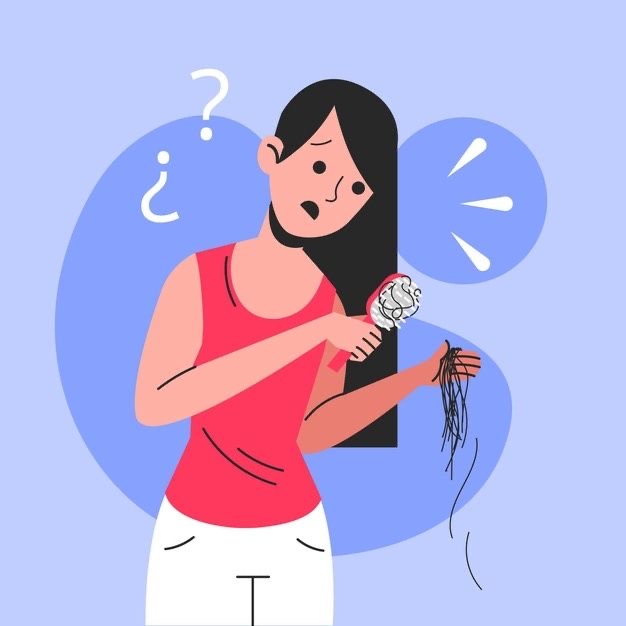
Table of Contents
Introduction Of Hair Loss
Hair loss, also known as alopecia, is a common condition that can affect individuals of all ages, genders, and backgrounds. It can manifest in various forms, ranging from temporary to permanent, and may result from multiple factors, including genetics, hormonal changes, underlying medical conditions, or simply the natural aging process. While anyone can experience hair loss, it is more prevalent among men. In this comprehensive guide, we will delve into the causes, symptoms, risk factors, prevention strategies, and available treatments for it.
Types and Symptoms
- 1. Male-Pattern Baldness (Androgenic Alopecia)
- Male-pattern baldness, also known as androgenic alopecia, is one of the most common causes of it in men. It typically begins with a receding hairline at the forehead, eventually leading to bald spots on the scalp. This pattern is a result of genetic predisposition and hormonal changes.
- 2. Female-Pattern Baldness
- Female-pattern baldness follows a different pattern than male-pattern baldness. Women often experience a broadening of the part in their hair, with thinning hair along the crown of the scalp. In some cases, women may also develop a receding hairline, a condition known as frontal fibrosing alopecia.
- 3. Patchy Hair Loss (Alopecia Areata)
- Alopecia areata is characterized by the sudden appearance of circular or patchy bald spots on the scalp, beard, or eyebrows. It may be accompanied by itching or discomfort before the hair falls out.
- 4. Traction Alopecia
- Traction alopecia is a type of it caused by repeated stress on the hair, often resulting from tight hairstyles like pigtails or cornrows. Over time, this can lead to hair thinning or loss.
- 5. Frontal Fibrosing Alopecia (Menopausal Women)
- Frontal fibrosing alopecia is becoming increasingly common among menopausal women. It involves the hairline receding backward, leading to noticeable in the frontal area of the scalp.
- 6. Sudden Hair Loss
- Suddenly can occur due to physical or emotional shocks. During such events, individuals may experience hair loosening, and they may notice hair falling out while combing, washing, or even gentle tugging. This type of hair loss often results in overall hair thinning but is usually temporary.
- 7. Full-Body Hair Loss
- Certain medical conditions and treatments, such as chemotherapy for cancer, can cause it throughout the entire body. Fortunately, the hair typically regrows after the underlying cause is addressed.
- 8. Scalp Scaling and Ringworm
- Patches of scaling that spread across the scalp can be a sign of ringworm, a fungal infection. This condition may lead to broken hair, redness, swelling, and sometimes oozing.
When to Seek Medical Attention
It is essential to consult a healthcare professional in specific hair loss scenarios:
- Persistent : If you or your child experience ongoing hair loss that causes distress, it’s advisable to seek medical advice to explore potential treatment options.
- Frontal Fibrosing Alopecia (Women): Women with a receding hairline due to frontal fibrosing alopecia should consult a doctor promptly to discuss early treatment options and prevent significant permanent baldness.
- Sudden or Patchy: The sudden onset of hair loss or the development of patchy bald spots warrants immediate medical attention. These symptoms may signal underlying medical conditions that require treatment.
- Excessive: If you notice an unusual amount of hair loss during routine activities like combing or washing, it’s advisable to consult a healthcare provider, especially in children.

Causes
It occurs when the natural process of hair growth and shedding is disrupted. Several factors can contribute to it, including:
- 1. Family History (Heredity)
- Heredity is a primary cause of it, often referred to as androgenic alopecia. This condition is linked to aging and typically manifests as male-pattern baldness in men and female-pattern baldness in women.
- 2. Hormonal Changes and Medical Conditions
- Hair loss can result from hormonal fluctuations due to events like pregnancy, childbirth, menopause, or thyroid problems. Conditions like alopecia areata, scalp infections such as ringworm, and trichotillomania (a hair-pulling disorder) can also lead to hair loss.
- 3. Medications and Supplements
- Certain medications used for various health conditions, including cancer, arthritis, depression, heart problems, gout, and high blood pressure, can have hair loss as a side effect.
- 4. Radiation Therapy
- In cases where radiation therapy is administered to the head, hair may not grow back in the same manner as before.
- 5. Stress
- Stress, whether physical or emotional, can trigger hair loss. Many individuals experience general hair thinning several months after a significant stress-inducing event. Fortunately, this type of it is usually temporary.
- 6. Hairstyles and Treatments
- Excessive hairstyling or hairstyles that exert significant tension on the hair, such as tight braids, cornrows, or pigtails, can lead to a type of hair loss known as traction alopecia. Additionally, hot-oil hair treatments and perms may cause hair to fall out, potentially resulting in permanent hair loss if scarring occurs.
Risk Factors
Several factors increase the risk of experiencing hair loss:
- Family History: A family history of baldness on either the maternal or paternal side can significantly increase the likelihood of developing hereditary hair loss.
- Age: It is often associated with aging, with the risk increasing as individuals grow older.
- Significant Weight Loss: Rapid and substantial weight loss can contribute to it.
- Medical Conditions: Certain medical conditions like diabetes and lupus can increase the risk of hair loss.
- Stress: High levels of stress, whether chronic or acute, can trigger or exacerbate hair loss.
- Poor Nutrition: A diet lacking essential nutrients can impact the health of hair, potentially leading to hair loss.
Prevention and Management
While some forms of hair loss, such as hereditary baldness, are not preventable, several strategies can help manage and reduce the risk of preventable hair loss:
- Gentle Hair Care: Treat your hair gently by using a detangler and avoiding vigorous tugging when brushing and combing, especially when your hair is wet. Consider using a wide-toothed comb to minimize hair breakage. Avoid harsh styling treatments like hot rollers, curling irons, hot-oil treatments, and perms. Limit hairstyles that exert tension on the hair, such as those involving rubber bands, barrettes, and tight braids.
- Medication Review: Consult with your doctor about any medications or supplements you are taking, as some may have it as a potential side effect.
- Sun Protection: Protect your hair from exposure to sunlight and other sources of ultraviolet light.
- Smoking Cessation: Quit smoking, as some studies suggest a link between smoking and male-pattern baldness.
- Chemotherapy and Cooling Caps: If you are undergoing chemotherapy, discuss the use of a cooling cap with your healthcare provider. Cooling caps can help reduce the risk of hair loss during chemotherapy.

Conclusion
It is a widespread and often distressing condition that can affect people of all backgrounds. While many factors can contribute to hair loss, understanding the underlying causes and seeking appropriate treatment is essential. By consulting with a healthcare professional and following preventive measures, individuals can manage hair loss effectively and, in some cases, promote hair regrowth. Remember that timely intervention and care are key to addressing hair loss and minimizing its impact on one’s quality of life.
Share this content:








